
After staying in hostels for most of the last week, we were so looking forward to our hotel in Lugano until we learned that use of the kitchenette was suspended during Covid unless we wanted to pay a hefty cleaning fee. That meant there was nary a plate, cup, etc to use. Luckily, we always bring along our little electric kettle that converts to 110.

Our hostel rooms had been far bigger than this 'double' room so I should have learned to be careful what I wished for. The hotel did have free laundry which was handy but it took over three hours to do one load, I kid you not.

One had to be a Cirque de Soleil contortionist to bend over and wash your feet in the shower, it was so small!
Just down toward Lake Lugano from our hotel was the attractive-looking Parco Villa Florida.
I can see that one of the big lures for people visiting Lugano would be its position on the lake of the same name and its being surrounded by mountains. Thank goodness we had chosen to take the funicular up to the top of the San Salvatore mountain the day before when we had drop-dead gorgeous panoramic views of the lake from every direction.
A sign indicated there were floating fish farms on the dock of the Porto del Belvedere for fish restocking on the lake so we kept searching for them until realizing that they consisted of containers covered by a nylon net at a depth of 45 feet and driven by an electric winch. In other words, nothing was visible from the surface!
A charming lakeside promenade:
There were lots of pretty sculptures in Giardino Belvedere, a little garden park between the lakeside promenade and the front of the Culture Museum.
This bust of George Washington of all people and a tall sequoia were all that remained of Villa Tanzina, a 19th-century residence that had been the home of Italian exile Abbondio Chiavilo before it was demolished in 1907.
It was certainly also odd seeing a rhinoceros sculpture by the lake.
What gives about a chain-link sculpture?
Now, this I could wrap my head around!
By the lakefront was the Church of St. Mary of the Angels, part of a monastery built by the Franciscans who already had a convent in Lugano and built this new property at the end of the 15th century, not far outside the town's southern gate. Recent restoration work revealed St. Francis frescoes in the cloisters and the coats-of-arms of representatives of the Swiss cantons.
There was no Mass but rather a tour group listening raptly to their guide!
So as not to disturb the group, we looked at the three frescoes painted by Milanese artist Bernardino Luini of The Last Supper that used to be one painting in the monks' refectory or dining room.
Once the tour group was gone, we were able to look closely at Bernini's The Passion and Crucifixion of Christ, described as the "artistic highlight of all Ticino and the finest Renaissance fresco in Switzerland." We could understand how Bernini was lauded as the 'Raphael of the North' for this exquisite piece.
At the bottom of the central crucifix were Adam's skull and femur and also the rib from which Eve was created.
The purpose of the fresco was to provide visual support to the sermons given from the pulpit that used to be on the left of the church. Luini spent ten years painting the frescoes, one section at a time over layers of wet plaster.
Bernini showed Jesus being crowned with thorns.
The doubting apostle Thomas was depicted touching Jesus' wound after the Resurrection.
And, above the apostles was The Ascension.
Frescoes of St. Sebastian and St. Roch framed the arch.
Beneath an arch were two large lunettes with one showing the city of Jerusalem and one showing the Mount of Olives. They apparently demonstrated the Franciscans had been the custodians of holy places since the 14th-century.
Adjacent to the church had been the Funicolare degli Angeli, the city's fourth cable line that opened in 1913 to link hotels on the lakeside with the upper parts of the city. The remarkable feat of engineering was equipped with a single car that operated by a system of counterweights located in a tower at the top of a hill. After being less and less used over the years, it was finally closed in 1987.
We were definitely not in the mood for that Cardio Walk Ticino!
One of the lakeside hotels the funicular used to link visitors to:
Just off the lakefront was Via Nassa, one of Lugano's main shopping streets where we enjoyed people watching and window shopping under typical Lombardi arcades.
A peek at the lake through a side street ...
and a grotto up an alleyway.
A busy street market on Via Pessina grabbed our attention.
The Grand Cafe al Porto was the most important in town and opened in 1803 when the canton of Ticino joined the Swiss Federation.
Its facade spoke of its origin as a convent.
The cafe had a remarkable history - in the waning days of World War II, Allen Dulles, the future head of the CIA, met here with Nazi and Italian representatives to discuss an end to the war that would prevent the Germans from ruining Italy in a scorched-earth retreat.
In happier times, Clark Gable and Sophia Loren also shared coffee here.
It was fun seeing several delicatessen-type shops on the busy corner that sold enormous sausages!
I could see how Piazza della Riforma was considered the city's living room as it was here that markets, local festivals, and open-air theaters thrived.
City Hall was the large yellow building.
So sorry, friends, I couldn't bring a few of these loaves of bread home in my bag to give you! They were, without a doubt, the longest I'd ever seen!
Ditto on the wheels of cheese!
It was fun wandering around the market stalls, seeing the local delicacies and handcrafted items.
Janina: I think these exquisite lace coasters, etc from almost a century ago would also have caught your eye.
Another of the delightful arcades similar to what we'd walked through earlier:
Palazzo Reali was originally a convent before serving for more than 200 years as the residence for a branch of the noble Morosini family. It was donated to the canton to be the headquarters for the Cantonal Art Museum in 1956.
Opposite the museum was the Church of San Rocco whose frescoes honored the saint credited for protecting Lugano against the plague.
More of Lugano's innovative modern art, I guess!
Just beyond the church was the small park of Piazza Indipendenza that featured a gargantuan head that was the world of Polish sculptor Igor Mitoraj. I'm writing this after returning from most of the day we spent exploring the ruins at Pompeii. The timing is a little too weird as what did we see but another Mitoraj sculpture there, too!
It was hard for me to think of an uglier building than this casino next to the piazza. It sure would act to deter any gambling impulses I might have!
Fortunately, the pretty Villa Ciani in City Park quickly restored our faith in the city's architecture. The villa was just a block from the lake and now housed a fine arts museum in a lush park.
Were these heart-healthy signs trying to tell us something?!
What a lovely combination of mountains and water views.
We had only ever seen a 'weather station' like this before in Interlaken just the day before.
It wasn't until we got up close to this whale sculpture that we realized it was a 'sound installation,' something I don't think we'd encountered before. What that meant was if we got too close to the whale, a sensor would activate lights so we would realize we needed to back away so as not to disturb a whale's space.
In the park, the Garden of the Righteous was a very small grove of trees that included powerful and heartwrenching stories of Jews or Jewish sympathizers who lived during the Nazi era. Federica Spitzer was a Viennese Jew who chose to be deported to Theresienstadt to save her parents' lives. After surviving the war, she gave personal testimony to children in Ticino schools of the horror of the concentration camps but also the "irrepressible power of human resistance."
One of the trees honored Carl Sommaruga, a Swiss diplomat who was chief advisor to the Swiss delegation in Rome during the war. He provided protection to Jewish families who were prosecuted by Nazi fascists by putting them up in his home and thereby risking his own life.
Francesco Alberti was a Catholic priest and director of the daily newspaper Popole e Liberta. He was one of the first in Ticino to unequivocally denounce the crimes and dangers of fascism and the atrocities of the Spanish Civil War.
San Salvatore, the mountain we'd hiked down the day before after arriving in Lugano from Interlaken:
City Park aka Parco Chiani was certainly a top highlight of our brief time in Lugano with its beautiful villa, exquisite flowers and gardens, and breathtaking views of the mountains and lake.
Once we realized these were mulberry trees along the lakefront, seeing all the locally-made silk scarves earlier in the shops made sense.
I don't remember seeing McDonald's having a prettier location anywhere.
Even though we'd been on a lake cruise on Zurichsee just a few days earlier, we treated ourselves to one on Lake Lugano as well as we'd read that the lake was "made to order for a boat trip."
Our 'plan' was to take the cruise to the small town of Gandria, still on the Swiss side of the lake, get off and walk around a bit, and then take the boat back. Ha - stay tuned! Hint - see the post title and also where Paradiso is near the bottom left of the map.
Seeing the huge fountain reminded me of the similar, but far more famous, Jet d'Eau fountain in Lake Geneva.
It was darn chilly to be out on the lake but there was no way I was going to stay inside and miss any of these marvelous views.
Vineyards growing close to the shore:
Grotto Elvezia was the last stop before we were going to explore Gandria.
Remember this spot!
When we noticed the Sentiero dell'Olivio or Olive Path back toward Lugano, we decided why not hike that as we were almost seasoned Swiss hikers by that point!
I should have waited to say I was all in until after seeing the steep path just to reach the small town!
Much to Steven's dismay, I spent several minutes in this ceramics shop dithering over whether to buy a lovely plate. I ended up not doing so out of concern I'd have to carry it for another five weeks, i.e. the entire time we'd be in Italy before flying home.
Gandria's one and only church:
Walking signs back to Lugano were a little basic, wouldn't you agree!
Because Gandria enjoyed a south-facing slope that exposed itself to the sun and a high annual average temperature, we read the town supported a unique variety of plant and animal species.
Guess we got in our heart-healthy Ticino walk after all although that wasn't part of the plan!
The Olive Path would be a delightful stroll for you and your family, Deb, if you ever make it back to Switzerland.
This was what we'd seen from the lake.
I wondered what had caused the interesting striations in the rock above the path.
I wondered if the boat was heading to some of the car-free towns along both the Swiss and Italian sides of the lake.
There really were a lot of olive trees growing along the path that bore its name!
The gate to one of the many palatial homes bordering the lake:
Definitely not my favorite sculpture in Lugano that day!
Lugano's Reformed Church dated from 1901.
We ended up walking all along the lake from Gandria to Paradiso, the spot nearest our hotel, also the location I pointed out on the map earlier. It was another lovely walk and certainly far, far easier than the grueling trek down San Salvatore I had no intention of repeating anytime soon. The stroll capped a perfect day in lovely Lugano on our last day in Switzerland.
Next post: Onto Italy for the next five weeks beginning in the delightful Lake Como region.
Posted on November 12th, 2021, from Naples, home of the first pizza if you believe the locals, and nearby Pompeii, Herculaneum, Vesuvius, and the Amalfi Coast.





































































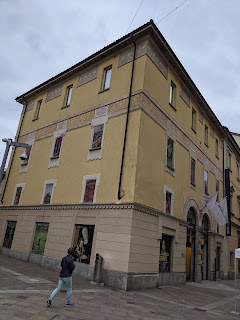

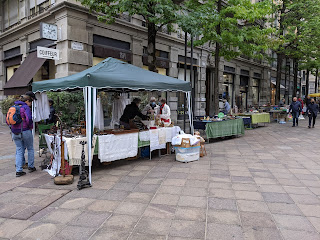






















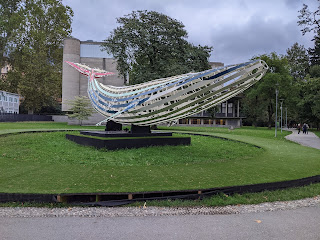










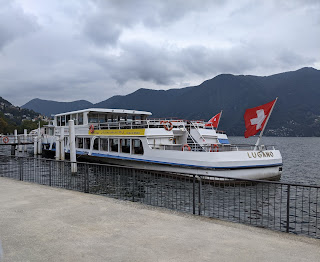
































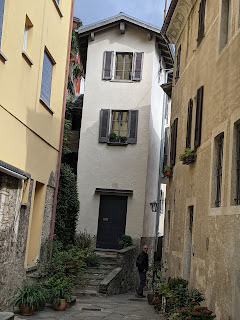












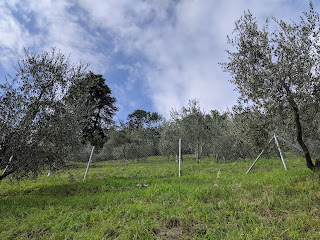







The sweets in the first photo look soooooo good. Are you bringing some home for me? Janina
ReplyDeleteWould that I could have - guess you and Pat will have to make a stop in Lugano one of these days and stop by the Grand Café yourself to savor these delectable morsels!
ReplyDelete